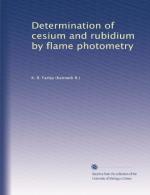|
This section contains 310 words (approx. 2 pages at 300 words per page) |
Rubidium is the fourth member of the alkali metal family, consisting of elements in Group 1 of the periodic table. Its atomic number is 37, its atomic mass is 85.4678, and its chemical symbol is Rb.
Properties
Rubidium is a soft, silvery metal with a melting point of 102°F (39°C), a boiling point of 1,270°F (688°C), and a density of 1.532 grams per cubic centimeter. It is one of the most active elements, reacting vigorously with oxygen, water, acids, and the halogens. It is so active, in fact, that it is usually stored under some organic liquid in order to prevent it from combining explosively with oxygen in the air.
Occurrence and Extraction
Rubidium is a relatively common element with an abundance of about 35-75 parts per million. Its most common ores are lepidolite, carnallite, and pollucite. It is also found in seawater and in mineral springs. The pure metal is obtained by the electrolysis of molten rubidium chloride (RbCl): 2RbCl --electric current 2Rb + Cl2.
Discovery and Naming
Rubidium was discovered in 1861 by the German chemists Robert Bunsen and Gustav Kirchoff. Bunsen and Kirchoff contributed to the development of the science of spectroscopy and used that science to analyze a number of well- known substances. During this analysis, they observed spectral lines that could not be attributed to any known element and assumed that they had found a new element. They proposed the name of rubidium for the element because of the dark red color of the most prominent of its spectral lines. In Greek, the word for "deep red" is rubidus.
Uses
Rubidium and its compounds have relatively few uses. It has seen some application in the manufacture of atomic clocks for specialized purposes in which very precise time-keeping is essential. It is also used occasionally in the manufacture of photocells, although other alkali metals are usually preferred for this purpose.
|
This section contains 310 words (approx. 2 pages at 300 words per page) |


